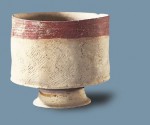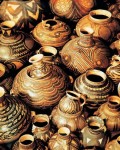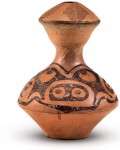Archive for the ‘China’s Cultural Relics’ Category
Painted patterns on Yangshao portery 2
What merit even greater attention, however, are painted pottery utensils found at a place also called “Miaodigou” on the foot of Mt. Huashan in Shaanxi. These are beautiful with strings of decorative patterns painstakingly designed and arranged. Research has led to the discovery that the workmen first used dots to mark the position of each pattern on the roughcast of a utensil, and then linked the patterns with straight lines or curved triangles to form a decorative belt vigorous and rhythmic in artistic style. A careful Produced 4,800-4,300 years ago, this pottery basin is one of the cultural relics unearthed at the Banpo ruins of the New Stone Age in Xi’an, Shaanxi Province. The decorative pattern features a human face witaltProduced 4,800-4,300 years ago, this pottery basin is one of the cultural relics unearthed at the Banpo ruins of the New Stone Age in Xi’an, Shaanxi Province. The decorative pattern features a human face wit viewer won’t miss those lines cut in intaglio or relief, forming rose flowers, buds, leaves and stems.
Pottery utensils of the same Yangshao culture that are found in different places invariably have different the me patterns for their decorative belts. Nevertheless, patterns with rose flowers as the theme decoration are found on pottery of all types, indicating an inherent link of theirs.
Painted patterns on Yangshao portery 1
In 1957, the so-called “Miaodigou branch of the Yangshao culture” became known with excavation of a primitive site at Miaodigou in Sanmenxia City, Henan Province, which archeologists believe existed during the transition of the Yangshao culture to the Longshan culture. Painted pottery utensils found at Miaodigou were produced around 3,900 years BC. Flying 4,800-4,300 years ago. It was unearthed at Baoji City, Shaanxi Province birds, distorted bird patterns done with crude lines and frogs in a style of realism are the main patterns on them.
Fish and distorted fish patterns, sometimes with fishing net patterns, characterize pottery utensils found at Banpo in Shaanxi Province. Archeologists believe these represent another branch of the Yangshao culture, which is earlier than the Miaodigou branch. Images of frogs are painted on the inner side of pottery basins found at Banpo, and deer are the only animal figures on Banpo pottery ware.
Decorative patterns on painted portery of the Yangshao culture
 Painted pottery of the Yangshao culture is recognized as the most representative of the prehistory painted pottery found in China.
Painted pottery of the Yangshao culture is recognized as the most representative of the prehistory painted pottery found in China.
Back in 1921, ruins of a primitive village were found at Yangshao Village, Mianchi County, Henan Province, which was to be identified as belonging to a highly developed matriarchal society existed in central China.
Many cultural relics have been unearthed from the site since then. Included are pottery utensils for daily use, which are valued not only for their cultural importance but also for the workmanship with which they were produced. Earth to be used for making the roughcasts with was rinsed and, for that, most products are of the same color as their roughcasts. To be more precise, products produced with roughcasts of fine mud are red, and those produced with roughcasts of fine mud mixed with fine grains of sand are brownish red.
Most decorative patterns were painted in black, and the rest in red.  Sometimes a thin layer of red or white coating was applied to the roughcasts, on which decorative patterns were then painted, in order to ensure a greater contrast of the colors.
Sometimes a thin layer of red or white coating was applied to the roughcasts, on which decorative patterns were then painted, in order to ensure a greater contrast of the colors.
The Yangshao culture dates back to a period from 5,000 years BC to 3,000 years BC. Primitive sites and ruins found later in other parts of central China are culturally similar to the Yangshao ruins. For that, the Yangshao culture has been recognized as synonym of the culture prevalent in central China during the matriarchal clan society – in a region with Gansu, Shaanxi and Henan as center while encompassing Hebei, Inner Mongolia, Shanxi, Qinghai, as well as parts of Hubei.
Development of painted portery
class=”alignleft size-thumbnail wp-image-359″ title=”a pottery jar of the Yangshao culture that existed 5,600 years ago, which” src=”http://www.chinascan.org/wp-content/uploads/2009/09/a-pottery-jar-of-the-Yangshao-culture-that-existed-5600-years-ago-which-91×150.jpg” alt=”a pottery jar of the Yangshao culture that existed 5,600 years ago, which” width=”55″ height=”90″ />At first, pottery vessels were produced just for practical use, as their producers had no time and energy to spare to “decorate” their products for some sort of aesthetic taste. Among the earliest pottery ware unearthed so far, only a few containers have crude lines painted red round their necks.
As life improved along with development of primitive agriculture, people came to have time to spare on undertakings other than for a mere subsistence – crop farming, hunting, animal raising, etc. While still serving people’s practical needs, pottery became something denoting people’s pursuit of beauty as well. Painted pottery came into being as a result, representing a great leap forward in the development of pottery–making. Among prehistoric relics we have found, painted pottery ware are the earliest artifacts featuring a combination of practical use and artistic beauty.
Painted pottery – making had its heyday 7,000-5,000 years ago, during the mid- and late periods of the New Stone Age. The most representative painted pottery ware, mostly containers and eating utensils, were produced in areas on the upper and middle reaches of the Yellow River including what is now Gansu and Shaanxi provinces, on which decorative lines and animal figures painted in color are found.
mid- and late periods of the New Stone Age. The most representative painted pottery ware, mostly containers and eating utensils, were produced in areas on the upper and middle reaches of the Yellow River including what is now Gansu and Shaanxi provinces, on which decorative lines and animal figures painted in color are found.
Without furniture with legs, prehistory people just sat on the ground when they ate or met. For this reason, decorative patterns and figures were painted on parts of a pottery vessel fully exposed to view – for example, the part below the inner or outer side of the mouth of a bowl and, in some cases, decorations on the inner side extending to the bottom. On a basin with an extruding belly, we find decorative patterns below and on the fringe of the mouth and above the curve.
In comparison, no decoration is seen below the curve because people sitting on the ground can hardlysee that part. In the case of a large basin, decorative patterns are found inside, on the upper side of the inner wall.  These are not on the outer wall, because people sitting round the basin cannot see it. Decorative patterns are found on the outer wall of a jar, mostly on the shoulder or above the belly. Small bottles in the shape of a gourd have decorative patterns all over them.
These are not on the outer wall, because people sitting round the basin cannot see it. Decorative patterns are found on the outer wall of a jar, mostly on the shoulder or above the belly. Small bottles in the shape of a gourd have decorative patterns all over them.